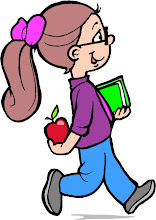Welcome to First Grade! I can't believe we have already completed our first week of schooling. This year we are using our schedule board again, it is so helpful to keep us on-track, make sure everything I need to do gets done, and K. knows exactly when things are happening. This dispels lots of questions and nagging.
This year my posts will be different from Kindergarten, as I will not be putting up EVERYTHING we do. You can check out the "First Grade" page for our curriculum schedule. Weekly posts will just have games and activities that worked really well, books I used that aren't listed with the curriculum, etc. So if I don't mention a subject, it doesn't mean we didn't do it, it just means that there wasn't anything that stood out in my memory to write about. You will also notice that the posts are by the Set of weeks, and I'm just adding each week to that post.
This year for our Reading Incentive Program, I put a strip of paper (I bought rolls of adding machine tape to use as borders on our bulletin boards.) numbered in 25 increments (up to 800) on one of our bulletin boards. On the paper we are keeping track of the new books K. reads. When she reaches the 800 she will get a special treat. I haven't decided on the treat yet. It depends on how quickly she reaches the goal. It could be anything, from going to Golden Spoon to $1 to spend at the Thrift Store to a couple books at the $1.00 Book Store.
I've made a "New School Year Resolution". It is to take at least one picture of K. everyday. I get so wrapped in "life" that I forget to take pictures. So this year the camera is sitting on our dining room table (our base for schooling) instead of on a shelf in my room. I haven't taken a picture EVERY day, but I am getting better about it.




















